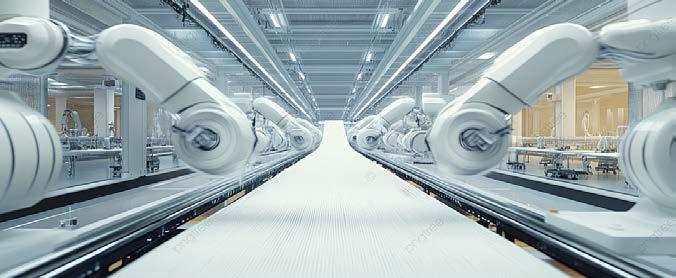Try GOLD - Free
The Impact of Textile Automation: Transforming an Industry Thread by Thread
Textile Value Chain
|October 2025
Walk into any modern textile factory today, and you'll witness something remarkable. Machines that once needed constant human guidance now hum along independently, making split-second decisions. Robots handle delicate fabrics with precision that would make veteran seamstresses nod in approval. This isn't science fiction; it's the reality reshaping the $31 billion textile machinery market right now.

The Numbers Tell a Story
Let's start with what's actually happening. According to Mordor Intelligence, the global textile machinery market stood at USD 31.10 billion in 2025 and is forecast to reach USD 40.11 billion by 2030, advancing at a 5.22% CAGR. But here's what matters more: according to a Technavio estimate, the automation in the textile industry market is forecast to increase by USD 664 million at a CAGR of 3.2% between 2024 and 2029.
What's driving this growth? Companies are tired of production bottlenecks, inconsistent quality, and margins that keep shrinking. They're looking at automation like a drowning person looks at a life raft.
Why Everyone's Racing to Automate
The reasons are straightforward, even if the solutions aren't simple.
Labour shortages have become critical. For instance, in Germany, many training posts remain unfilled, pointing to a wider skills-gap issue. Young people aren't lining up for factory jobs like previous generations did. Meanwhile, experienced workers are retiring, taking decades of knowledge with them.
Quality consistency is nonnegotiable now. Consumers won't accept defects, and brands can't afford recalls. Automated inspection systems can detect defects in fabrics with minimal human intervention, and innovations such as automation, artificial intelligence, and IoT integration are streamlining operations, reducing labour costs, and minimising waste.
Energy efficiency matters—to both profits and the planet. Textile manufacturers are increasingly financing automation technology, predictive maintenance, and Al-driven workflow management to optimise energy consumption and reduce costs. When machines can self-monitor and optimise their own energy use, savings compound quickly.
This story is from the October 2025 edition of Textile Value Chain.
Subscribe to Magzter GOLD to access thousands of curated premium stories, and 10,000+ magazines and newspapers.
Already a subscriber? Sign In
MORE STORIES FROM Textile Value Chain

Textile Value Chain
TMMA's 65th Annual General Meeting: Charting the Future of India's Textile Machinery Sector
The Textile Machinery Manufacturers' Association (India) successfully organised its 65th Annual General Meeting (AGM), Export and R&D Awards Function, and a high-level stakeholder consultation at the India ITME Centre, Mumbai. The event brought together industry leaders, policymakers, and innovators to reflect on the current state of the textile machinery sector and chart the path forward.
6 mins
October 2025

Textile Value Chain
Textile Circularity - A Decade of Experiments and Experiences at Meemansa
The textile industry is a paradox: it is a generator of beauty, culture, and livelihoods - yet also one of the most resource-intensive and waste-producing sectors in the world.
6 mins
October 2025

Textile Value Chain
Your Next Big Buyer Won't Ask for Price - They'll Ask for Your Scope 3
Every time we make a piece of clothing — from buying cotton to spinning yarn, weaving fabric, stitching garments, transporting, and even the way the customer washes it — we leave behind a footprint.
3 mins
October 2025

Textile Value Chain
Textile Automation Impact
We explore how automation is redefining the textile and apparel industries not just in technology, but in the very foundation of production, sustainability, and competitiveness.
4 mins
October 2025

Textile Value Chain
India Gets its First: Liva Reviva TM M Marks a New Milestone in Recycled Cellulosic Fibre
Redefining fashion's environmental future, Birla Cellulose has introduced Liva Reviva™ M: India's first next-generation circular fibre.
1 mins
October 2025

Textile Value Chain
NIT Jalandhar Signs MoU with Tynor Orthotics, Mohali
The Department of Textile Technology at Dr B. R. Ambedkar National Institute of Technology (NIT), Jalandhar, has signed a Memorandum of Understanding (MoU) with Tynor Orthotics Pvt. Ltd., a leading Indian manufacturer of orthopaedic and healthcare products.
1 min
October 2025

Textile Value Chain
It's the Machine Era...Upgrade to Safeguard & Magnify Textiles!!!
Our world is surrounded by automated systems; we wake up to the chirping sounds of alarms, and with another touch, the coffee maker starts brewing.
7 mins
October 2025

Textile Value Chain
Recycled Polyester Fabric: From Plastic Bottles to Your Wardrobe
Every day, millions of plastic bottles end up in trash bins around the world.
4 mins
October 2025

Textile Value Chain
Geopolitical Risks and the Future of Indian Textile Exports: Navigating an Uncertain World
The global textile trade, once anchored in predictable economic cycles and established trade corridors, now finds itself navigating one of the most volatile geopolitical landscapes in decades. From the Russia x Ukraine war to the conflict in West Asia, from U.S. x China, U.S. x India tariff hostilities to fragmented global trade alliances, uncertainty has become the new constant.
4 mins
October 2025

Textile Value Chain
The Impact of Textile Automation: Transforming an Industry Thread by Thread
Walk into any modern textile factory today, and you'll witness something remarkable. Machines that once needed constant human guidance now hum along independently, making split-second decisions. Robots handle delicate fabrics with precision that would make veteran seamstresses nod in approval. This isn't science fiction; it's the reality reshaping the $31 billion textile machinery market right now.
6 mins
October 2025
Listen
Translate
Change font size
